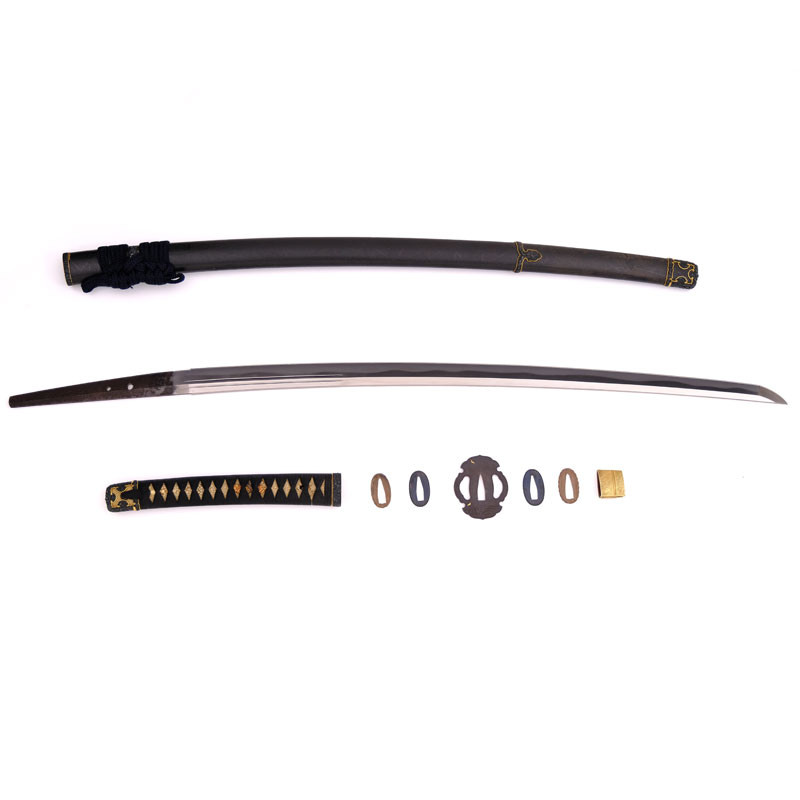





















































More informations about this product
| Total Weight | 1.215 kg | |
| Weight without Saya | 1.186 kg | |
| Blade Weight | 0.999 kg | |
| Full Blade length (Toshin) | 90.90 cm | |
| Nagasa | 70.00 cm | |
| Nakago Length | 20.90 cm | |
| Sori (curvature) | 1.65 cm | |
| Kissaki Length | 3.60 cm | |
| Moto Haba | 3.16 cm | |
| Saki Haba | 3.10 cm | |
| Moto Kasane | A = 0.60 cm B= 0.71 cm |
|
| Saki Kasane | A = 0.41 cm B = 0.46 cm |
|
| Curvature | Tori Sori | |
| Type Kissaki | Chu Kissaki Elongated | |
| Blade Structure | Shinogi Zukuri (diamond shaped) | |
| Mune | Iori Mune (triangular) | |
| Bohi | Gomabashi on Omote side and Koshi-Bi on Ura side | |
| Hamon | Notare based on Nie, and wide Nioi Guchi Presence of Ashi, Sunagashi, Kinsuji |
|
| Hada | Ko-itame Hada with Ji Nie | |
| Boshi | Ko Maru Kaeri | |
| Nakago | Ubu, signed on the Omote side 以南蛮鉄越前住包則 «Motte Nanban Tetsu Echizen Ju Kanenori», 2 Mekugi Ana, classical form Futsu Gata, Yasurime obliques Sujikai, rounded end Kuri Jiri. | |
| Saya | Weight 218g, length 74.80cm, Saya lacquered black mast ishimeji-nuri type with geometric patterns, Sageo in dark blue silk, Handachi assembly in suite with the presence of Ishizuki, ShibaBiki, Kurigata and Koiguchi in Shakudo with Chrysanthemum motifs. Set of pieces signed and made by 味墨政信 (花押) Miboku Masanobu. | |
| Tsuka & Tosogu (Tsuba, Menuki, Fuchi Kashira) |
- Tsuka: Weight 127g, length 26.4cm, High-end Jabara Ito braiding in black silk, Same whole high-quality white, Menuki finely chiseled and gilded with chrysanthemum leaves and flowers, Fuchi and Kabuto Gane in suite with Handachi montage in Shakudo with patterns of leaves and chrysanthemum flowers. Set of pieces signed and made by 味墨政信(花押) Miboku Masanobu. - Tsuba: Weight 77g, dimensions 7.51 x 6.29 x 0.39 cm, Shitogi Gata shaped tsuba, in black patinated steel, with the motifs of «Nami Chidori» («Thousand birds on the waves») symbol of resistance and triumph in the face of adversity. -Habaki: 29g, Habaki in gilded copper, Shonai type with oblique Neko Gaki - Seppa : 2 Classic Crenellated Seppa (2x6g) and 2 Thick Seppa with Niche Borders (2x6.5g). |
|
| Study & Team Review |
There have been 3 generations of blacksmiths named Echizen Ju Kanenori 越前住包則. This lineage originated from the Sanami 三阿弥 school of Mino, founded by Kanenori 兼則. This one moved from Mino to Echigo during the Tenbun period (1532-1555). His eldest son, with the same name Kanenori 兼則, is considered the 2nd generation Kanenori 兼則, and moved to Echizen. It was part of the Echizen-Seki branch (越前関). Kanenori 包則 1st generation, with kanji 包, who is none other than the younger brother of the second generation Kanenori 兼則. Kanenori 包則 1st gen, lived in late Momoyama (1573 to 1603) and early Edo period. His civil name was Shinpachi 新八, born in 1574 and died in 1642 at the age of 68. One can observe an evolution in his career, at first he forged in the style Sue Seki, then, in Echizen he worked in the style of the Yasutsugu lineage. His son, 2nd generation Kanenori 包則, apparently became affiliated through a marriage, with the branch “Echizen-Shimosaka” (越前下坂). It then took the civil name of Shimosaka Ichizaemon (下坂市左衛門) and was active from 1635 to 1675 approximately. Affiliated with the Shimosaka branch, he worked with the Yasutsugu lineage for the Shogun Tokugawa. His blades are classified Wazamono. Finally, the 3rd generation Kanenori 包則, active around 1685, who also worked in Edo and had the honorary title of Yamato No Daijo. The province of Mino experienced significant growth during the Momoyama period and early Edo. This forging tradition was heavily solicited by the local lords and the blades were known for their durability and sharpness. North of Mino is the province of Echizen, where many blacksmiths settled over the years and especially after the Battle of Sekigahara. After Sekigahara, this province was led by Matsudaira Hideyasu, 3rd son of the Shogun Tokugawa Ieyasu. In this province, there are two main lines of blacksmiths, “Echizen-Seki” (越前関) and “Echizen-Shimosaka” (越前下坂). The Echizen Seki branch was the first to establish itself in the Tenbun period (1532-1555), with blacksmiths from Mino such as Kanenori (兼法), Kanenori (兼則) and Kanetsune (兼常). All these blacksmiths from the Mino tradition have names of artists recognizable by the kanji “Kane” used in the form 兼. There are other blacksmiths using another kanji “Kane” 包, referring instead to Kanenaga 包永, founder of the Tegai school of Yamato tradition. This blade from the 2nd generation Kanenori 包則 is very similar to the work of the famous Echizen Yasutsugu, blacksmith of Ieyasu Tokugawa. Like Yasutsugu, Enorkani regularly used foreign steel for these achievements, Nanban Tetsu 以南蛮鉄. And he also had the privilege of forging for the Tokugawa Shogun. Very beautiful and elegant handachi assembly with Tosogu signed by 味墨政信 Miboku Masanobu. Ooka Masanobu 大岡政信, 4th generation of the famous Hamano 浜野 school, founded the Ooka branch. He lived in the early 19th century (1773-1844). This Ooka branch was at the service of the Owari Tokugawa family and Masanobu is considered one of the most talented artists of the Hamano school, even more than the founder of the Hamano school, Shozui 政随. This is a sumptuous montage. |
|
Share your opinion
error Your review appreciation cannot be sent
feedback Report comment
check_circle Report sent
error Your report cannot be sent